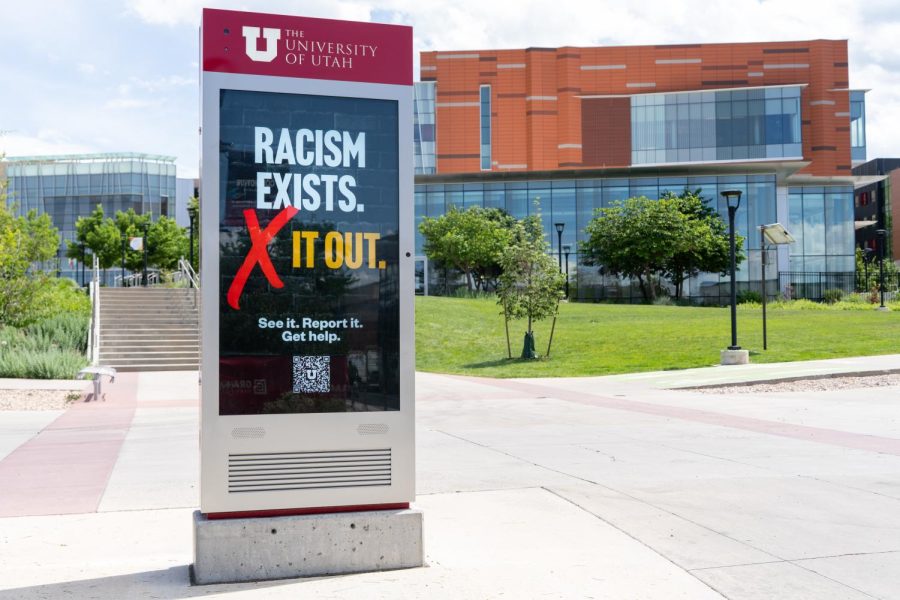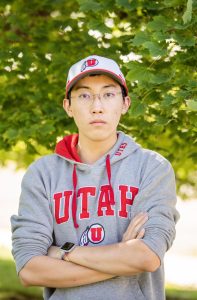U’s Racist and Bias Incident Response Team Discuss Their Role on Campus
A digital board displaying a sign that says “Racism exists. X it out.” on the University of Utah campus in Salt Lake City on Wednesday, June 7, 2023. (Photo by Xiangyao “Axe” Tang | The Daily Utah Chronicle)
June 8, 2023
Across the University of Utah’s campus, screens flash with a message to report racist and biased incidents, but what happens to the reports after they’re filed? They are seen by the Racist and Bias Incident Response Team, followed by other relevant university departments to determine the best course of action.
Within a large campus, there are many departments that must communicate with students about any incident that occurs within their jurisdiction. The creation of the Racist and Bias Incident Response Team, or RBIRT, was intended to centralize the response to these incidents and mitigate communication errors that may occur across the U.
The team was created in 2019 and is comprised mainly of faculty members, administrators and an elected student representative. This team collaborated with the Office of Equal Opportunity, Affirmative Action, and Title IX, known as OEO, as well as the University Police Department.
The Work of the RBIRT
The RBIRT deals with reported hate speech or actions, which target individuals or groups on the basis of identity such as ethnicity, religion and sexual orientation. The reporters of the incident are involved in the team’s communication about it, which may involve sending an alert out to inform U students of what took place.
The RBIRT website is regularly updated to include information about reported incidents, including details about what happened and actions being taken to address the event.
Jason Ramirez, the associate vice president of student affairs and dean of students, said the team always aims to prioritize the reporting student when handling these situations.
“Making sure that they’re okay with that communication going out because oftentimes, these situations … they’re traumatizing for the people who go through them,” Ramirez said.
The RBIRT reaches out to the individual who reported the incident and explains what resources the team offers and the next steps. They are given the opportunity to continue an investigation with OEO and/or the UPD depending on the level of the incident.
Benvin Lozada, who was the 2022-2023 ASUU vice president of university relations, sat on the board for a year and provided a student perspective. He also served on a subsection of the group called the critical incident response team.
Lozada said teamwork was important when completing reports in response to incidents, as it ensured different perspectives were incorporated in the decision-making.
“Everyone kind of [provides] their own insights, their own experience,” Lozada said. “And we kind of create this unified plan and create unified statements … to make the most effective thing possible.”
Despite the challenging reports that come to the team, they aim to have a unified front and acknowledge the wrongdoings of the accused perpetrators. The members of the team expressed that they aim for transparency.
With respect to the victims, the team aims to be as transparent as possible about what took place so that the situation doesn’t go unnoticed. Ramirez stated how important this information is for people of marginalized identities, so they can make informed decisions.
The RBIRT continues to grow its resources to keep people informed about events concerning targeted communities.
Annalisa Purser, special assistant to the vice president for student affairs, spoke about the direction RBIRT aims to continue growing to better assist the campus community.
“We’ve been gathering information about … where, who is being targeted,” Purser said. “This is information we didn’t know previously and we just are starting to get that because, you know, it took a while just to let people know this process existed and then get people using it.”
As the team’s resources continue to grow, the aim stays the same, to ease the situation by managing communication, and guide victims to the proper resources.
“We’re going to take steps to make our campus community better,” Ramirez said.









